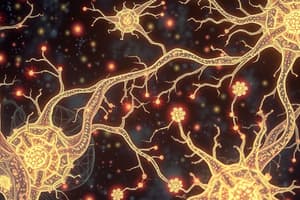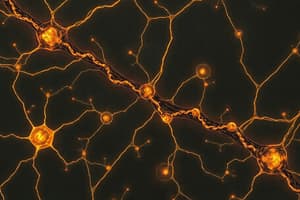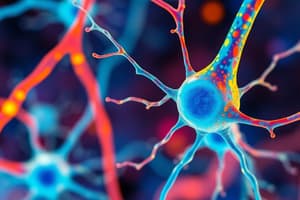Podcast
Questions and Answers
Which of the following best describes the primary role of the sodium-potassium pump in maintaining a neuron's resting membrane potential?
Which of the following best describes the primary role of the sodium-potassium pump in maintaining a neuron's resting membrane potential?
- To actively transport sodium ions out of the neuron and potassium ions into the neuron, counteracting ion leakage. (correct)
- To passively regulate the flow of ions based on the existing electrical gradient without expending energy.
- To facilitate the diffusion of sodium ions into the neuron and potassium ions out of the neuron.
- To create a concentration gradient by allowing equal amounts of sodium and potassium ions to cross the membrane.
During the generation of an action potential, what is the immediate effect of the opening of voltage-gated sodium channels on the neuron's membrane potential?
During the generation of an action potential, what is the immediate effect of the opening of voltage-gated sodium channels on the neuron's membrane potential?
- Repolarization due to an influx of negative ions.
- Stabilization of the resting membrane potential at -70 mV.
- Depolarization due to an influx of sodium ions. (correct)
- Hyperpolarization due to an efflux of potassium ions.
How would blocking potassium channels in a neuron's membrane most likely affect the neuron's ability to generate action potentials?
How would blocking potassium channels in a neuron's membrane most likely affect the neuron's ability to generate action potentials?
- It would prevent the initial depolarization phase of the action potential.
- It would have no significant effect on the action potential.
- It would cause the neuron to hyperpolarize, making it more excitable.
- It would prevent the repolarization phase of the action potential, prolonging the depolarization. (correct)
What initiates the repolarization phase of an action potential?
What initiates the repolarization phase of an action potential?
A certain neurotoxin prevents the sodium channels' inside door from closing. What is the most likely effect on the neuron?
A certain neurotoxin prevents the sodium channels' inside door from closing. What is the most likely effect on the neuron?
How does the concentration gradient of sodium and potassium ions contribute to the neuron's resting membrane potential?
How does the concentration gradient of sodium and potassium ions contribute to the neuron's resting membrane potential?
What would happen to a neuron if the sodium-potassium pump stopped functioning?
What would happen to a neuron if the sodium-potassium pump stopped functioning?
Which statement accurately describes the state of sodium channels at the resting membrane potential?
Which statement accurately describes the state of sodium channels at the resting membrane potential?
What is the primary mechanism by which the original ion balance is restored after hyperpolarization?
What is the primary mechanism by which the original ion balance is restored after hyperpolarization?
How does the influx of sodium ions during an action potential contribute to the propagation of the signal along the axon?
How does the influx of sodium ions during an action potential contribute to the propagation of the signal along the axon?
During action potential propagation, what directly triggers the release of neurotransmitters?
During action potential propagation, what directly triggers the release of neurotransmitters?
What would be the most likely effect of a toxin that blocks the opening of potassium channels in a neuron?
What would be the most likely effect of a toxin that blocks the opening of potassium channels in a neuron?
How does the duration of the action potential (2-3 milliseconds) relate to the neuron's ability to transmit information?
How does the duration of the action potential (2-3 milliseconds) relate to the neuron's ability to transmit information?
What is the primary reason the resting membrane potential of a neuron is negative?
What is the primary reason the resting membrane potential of a neuron is negative?
How does the selective permeability of the neuron's membrane to specific ions contribute to the generation of an action potential?
How does the selective permeability of the neuron's membrane to specific ions contribute to the generation of an action potential?
During an action potential, what event is directly responsible for the rapid depolarization of the neuron?
During an action potential, what event is directly responsible for the rapid depolarization of the neuron?
What is the role of the sodium-potassium pump in maintaining the electrochemical gradient necessary for neuron function?
What is the role of the sodium-potassium pump in maintaining the electrochemical gradient necessary for neuron function?
How does the opening of potassium channels contribute to the repolarization phase of the action potential?
How does the opening of potassium channels contribute to the repolarization phase of the action potential?
At the peak of an action potential, what prevents the neuron's membrane potential from reaching an even higher positive value?
At the peak of an action potential, what prevents the neuron's membrane potential from reaching an even higher positive value?
What would be the most likely effect of a drug that permanently opens potassium channels in a neuron?
What would be the most likely effect of a drug that permanently opens potassium channels in a neuron?
How do neurons use action potentials to communicate information?
How do neurons use action potentials to communicate information?
Flashcards
Neurons
Neurons
Cells in the brain and nervous system that communicate via action potentials, enabling thinking, movement, and sensory perception.
Sodium Ions (Na+)
Sodium Ions (Na+)
Positively charged ions more concentrated outside the neuron, crucial for action potentials.
Potassium Ions (K+)
Potassium Ions (K+)
Positively charged ions more concentrated inside the neuron; some leak out, contributing to resting membrane potential.
Membrane Potential
Membrane Potential
Signup and view all the flashcards
Depolarization
Depolarization
Signup and view all the flashcards
Repolarization
Repolarization
Signup and view all the flashcards
Sodium-Potassium Pump
Sodium-Potassium Pump
Signup and view all the flashcards
Action Potential
Action Potential
Signup and view all the flashcards
Sodium-Potassium Pump Function
Sodium-Potassium Pump Function
Signup and view all the flashcards
Ion Channels
Ion Channels
Signup and view all the flashcards
Sodium Channel Opening Effect
Sodium Channel Opening Effect
Signup and view all the flashcards
Potassium Movement
Potassium Movement
Signup and view all the flashcards
Threshold Potential
Threshold Potential
Signup and view all the flashcards
Sodium-Potassium Pump Function
Sodium-Potassium Pump Function
Signup and view all the flashcards
Channel Speed
Channel Speed
Signup and view all the flashcards
Hyperpolarization
Hyperpolarization
Signup and view all the flashcards
Restoring Ion Balance
Restoring Ion Balance
Signup and view all the flashcards
Action Potential Propagation
Action Potential Propagation
Signup and view all the flashcards
Depolarization of Adjacent Axon
Depolarization of Adjacent Axon
Signup and view all the flashcards
Neurotransmitters
Neurotransmitters
Signup and view all the flashcards
Study Notes
- Neurons facilitate communication in the brain and nervous system via action potentials.
- Neurons enable thinking, movement, and sensory perception.
- Communication involves the exchange of ions like Sodium and Potassium across the neuron's membrane.
Sodium Ions (Na+)
- Sodium ions (Na+) have a positive charge.
- They are more concentrated outside the neuron.
- Only a few sodium ions are found inside the neuron.
- This creates a concentration gradient.
Potassium Ions (K+)
- Potassium ions (K+) also carry a positive charge.
- Potassium is more concentrated inside the neuron.
- Potassium ions leak out of the neuron.
- They move down the concentration gradient.
- This leakage is less than sodium leaks.
Membrane Potential
- The inside of the neuron is negatively charged compared to the outside due to ion concentration differences.
- A greater amount of potassium leaks out than sodium leaks in.
- This charge difference is the electrical/membrane potential, which is measured in millivolts (mV).
- Membrane potential indicates the electrical potential across a neuron's membrane over time.
- Resting neuron membrane potential is typically -70 mV, and is when a neuron isn't firing.
- Depolarization happens when the neuron becomes less negative.
- Repolarization is when the neuron returns to its resting membrane potential.
Sodium-Potassium Pump
- The sodium-potassium pump actively transports three sodium ions out for every two potassium ions it brings in.
- The pump maintains ion gradients necessary for membrane potential.
- The pump counteracts ion leakage to maintain the resting potential.
- The pump helps maintain the charge difference (electrical potential) across the neuron's membrane.
- This pump counteracts sodium leaking in and potassium leaking out, restoring them to their original sides of the membrane.
Action Potential Generation
- Neurons use sodium and potassium gradients and channels to generate a digital pulse called the action potential.
- Action potentials travel along the neuron's axon.
- They transmit signals to other neurons.
- Sodium and potassium channels in the axon membrane facilitate ion flow.
- The axon membrane contains many sodium and potassium channels.
- Sodium channels act like hallways with doors that allow only sodium ions into the neuron.
- Potassium channels act like hallways with doors that allow only potassium ions out of the neuron.
- At rest, the sodium channel's outside door is closed, but the inside door is open; the potassium channel door is closed.
Sodium Channels
- When a neuron is at rest, the sodium channel outside door is closed but its inside door is open
- Depolarization opens the fast outside door of sodium channels allowing sodium ions to rush into the cell.
- The influx of sodium ions causes further depolarization.
- This leads to the opening of more sodium channels.
- A positive feedback loop is created until the threshold for starting an action potential is reached.
- Depolarization also slowly closes the sodium channel inside door.
Potassium Channels
- After sodium influx, potassium channels open, allowing potassium ions to flow out of the cell.
- The efflux of potassium ions makes the membrane potential more negative, causing repolarization.
- Potassium channel doors close slowly causing hyperpolarization for a moment, which is below the resting membrane levels.
- Afterwards, the membrane potential returns to resting levels.
- As the membrane potential repolarizes, potassium channels slowly close, sodium channel outside doors rapidly close, and sodium channel inside doors slowly open.
- Potassium channels stay open longer, causing the membrane potential to briefly hyperpolarize (go below resting levels).
- The membrane potential eventually returns to resting levels.
- The sodium-potassium pump then restores the original ion balance.
- The action potential process occurs rapidly, taking only 2-3 milliseconds at one point in the axon.
Action Potential Propagation
- The influx of sodium ions at one location on the axon depolarizes the adjacent section.
- If the depolarization is sufficient, it triggers an action potential in the adjacent section.
- The action potential is regenerated along the axon, propagating the signal.
- To send a message, the action potential must travel along the axon.
- As sodium ions rush into the axon at one location, they depolarize the next section of the axon.
- If the next piece of axon depolarizes enough, an action potential occurs there as well.
- The action potential is regenerated repeatedly along the axon, appearing to travel from the cell body to the axon terminal.
Neurotransmitter Release
- The action potential triggers the release of neurotransmitters when it reaches the nerve terminal.
- When the nerve terminal depolarizes, it releases neurotransmitters (chemical signals) that are received by the dendrites of the next neuron.
- Neurotransmitters are detected by the dendrites of the next neuron.
- The signal transmits to the next cell, and the entire process then repeats.
- This process repeats in the next neuron, propagating the signal.
Studying That Suits You
Use AI to generate personalized quizzes and flashcards to suit your learning preferences.




